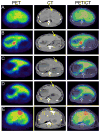Tumor uptake of hollow gold nanospheres after intravenous and intra-arterial injection: PET/CT study in a rabbit VX2 liver cancer model
- PMID: 23608932
- PMCID: PMC4164961
- DOI: 10.1007/s11307-013-0635-x
Tumor uptake of hollow gold nanospheres after intravenous and intra-arterial injection: PET/CT study in a rabbit VX2 liver cancer model
Abstract
Purpose: This study was designed to investigate the intratumoral uptake of hollow gold nanospheres (HAuNS) after hepatic intra-arterial (IA) and intravenous (IV) injection in a liver tumor model.
Materials and methods: Fifteen VX2 tumor-bearing rabbits were randomized into five groups (n = 3 in each group) that received either IV (64)Cu-labeled PEG-HAuNS (IV-PEG-HAuNS), IA (64)Cu-labeled PEG-HAuNS (IA-PEG-HAuNS), IV cyclic peptide (RGD)-conjugated (64)Cu-labeled PEG-HAuNS (IV-RGD-PEG-HAuNS), IA RGD-conjugated (64)Cu-labeled PEG-HAuNS (IA-RGD-PEG-HAuNS), or IA (64)Cu-labeled PEG-HAuNS with lipiodol (IA-PEG-HAuNS-lipiodol). The animals underwent PET/CT 1 h after injection, and uptake expressed as percentage of injected dose per gram of tissue (%ID/g) was measured in tumor and major organs. The animals were euthanized 24 h after injection, and tissues were evaluated for radioactivity.
Results: At 1 h after injection, animals in the IA-PEG-HAuNS-lipiodol group showed significantly higher tumor uptake (P < 0.001) and higher ratios of tumor-to-normal liver uptake (P < 0.001) than those in all other groups. The biodistribution of radioactivity 24 h after injection showed that IA delivery of PEG-HAuNS with lipiodol resulted in the highest tumor uptake (0.33 %ID/g; P < 0.001) and tumor-to-normal liver ratio (P < 0.001) among all delivery methods. At 24 h, the IA-RGD-PEG-HAuNS group showed higher tumor uptake than the IA-PEG-HAuNS group (0.20 vs. 0.099 %ID/g; P < 0.001).
Conclusion: Adding iodized oil to IA-PEG-HAuNS maximizes nanoparticle delivery to hepatic tumors and therefore may be useful in targeted chemotherapy and photoablative therapy. PET/CT can be used to noninvasively monitor the biodistribution of radiolabeled HAuNS after IV or IA injection.
Figures








Similar articles
-
Hepatocellular Carcinoma: Intra-arterial Delivery of Doxorubicin-loaded Hollow Gold Nanospheres for Photothermal Ablation-Chemoembolization Therapy in Rats.Radiology. 2016 Nov;281(2):427-435. doi: 10.1148/radiol.2016152510. Epub 2016 Jun 27. Radiology. 2016. PMID: 27347765 Free PMC article.
-
Pharmacokinetics, clearance, and biosafety of polyethylene glycol-coated hollow gold nanospheres.Part Fibre Toxicol. 2014 May 30;11:26. doi: 10.1186/1743-8977-11-26. Part Fibre Toxicol. 2014. PMID: 24886070 Free PMC article.
-
Pegylated Arg-Gly-Asp peptide: 64Cu labeling and PET imaging of brain tumor alphavbeta3-integrin expression.J Nucl Med. 2004 Oct;45(10):1776-83. J Nucl Med. 2004. PMID: 15471848
-
Selective uptake and imaging of aptamer- and antibody-conjugated hollow nanospheres targeted to epidermal growth factor receptors overexpressed in head and neck cancer.ACS Nano. 2014 May 27;8(5):4530-8. doi: 10.1021/nn406632u. Epub 2014 Apr 24. ACS Nano. 2014. PMID: 24754567 Free PMC article.
-
Effects of Near-infrared Laser Irradiation of Biodegradable Microspheres Containing Hollow Gold Nanospheres and Paclitaxel Administered Intraarterially in a Rabbit Liver Tumor Model.J Vasc Interv Radiol. 2012 Apr;23(4):553-61. doi: 10.1016/j.jvir.2011.12.017. Epub 2012 Feb 15. J Vasc Interv Radiol. 2012. PMID: 22341633 Free PMC article.
Cited by
-
Vascular targeting of nanoparticles for molecular imaging of diseased endothelium.Adv Drug Deliv Rev. 2017 Apr;113:141-156. doi: 10.1016/j.addr.2016.09.006. Epub 2016 Sep 15. Adv Drug Deliv Rev. 2017. PMID: 27639317 Free PMC article. Review.
-
Gold nanoparticles enlighten the future of cancer theranostics.Int J Nanomedicine. 2017 Aug 22;12:6131-6152. doi: 10.2147/IJN.S140772. eCollection 2017. Int J Nanomedicine. 2017. PMID: 28883725 Free PMC article. Review.
-
Radiolabeled theranostics: magnetic and gold nanoparticles.Bioimpacts. 2016;6(3):169-181. doi: 10.15171/bi.2016.23. Epub 2016 Sep 30. Bioimpacts. 2016. PMID: 27853680 Free PMC article. Review.
-
Targeted nanotechnology for cancer imaging.Adv Drug Deliv Rev. 2014 Sep 30;76:79-97. doi: 10.1016/j.addr.2014.08.002. Epub 2014 Aug 9. Adv Drug Deliv Rev. 2014. PMID: 25116445 Free PMC article. Review.
-
Nuclear molecular imaging with nanoparticles: radiochemistry, applications and translation.Br J Radiol. 2015 Oct;88(1054):20150185. doi: 10.1259/bjr.20150185. Epub 2015 Jul 2. Br J Radiol. 2015. PMID: 26133075 Free PMC article. Review.
References
-
- Hong K, Georgiades CS, Geschwind JF. Technology insight: Image-guided therapies for hepatocellular carcinoma--intra-arterial and ablative techniques. Nat Clin Pract Oncol. 2006;3:315–324. - PubMed
-
- Ridge JA, Collin C, Bading JR, Hancock C, Conti PS, Daly JM, Raaf JH. Increased adriamycin levels in hepatic implants of rabbit Vx-2 carcinoma from regional infusion. Cancer Res. 1988;48:4584–4587. - PubMed
-
- Farrell D, Ptak K, Panaro NJ, Grodzinski P. Nanotechnology-Based Cancer Therapeutics-Promise and Challenge-Lessons Learned Through the NCI Alliance for Nanotechnology in Cancer. Pharm Res. 2010;28:273–278. - PubMed
-
- Maeng JH, Lee DH, Jung KH, Bae YH, Park IS, Jeong S, Jeon YS, Shim CK, Kim W, Kim J, Lee J, Lee YM, Kim JH, Kim WH, Hong SS. Multifunctional doxorubicin loaded superparamagnetic iron oxide nanoparticles for chemotherapy and magnetic resonance imaging in liver cancer. Biomaterials. 2010;31:4995–5006. - PubMed
Publication types
MeSH terms
Substances
Grants and funding
LinkOut - more resources
Full Text Sources
Other Literature Sources
Medical

